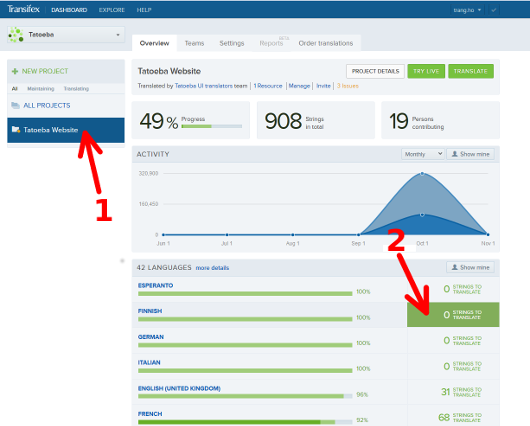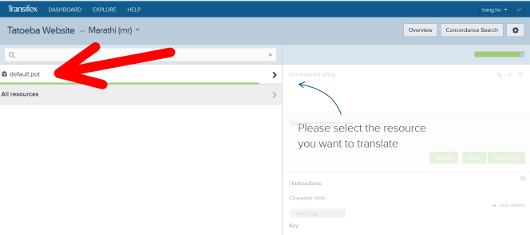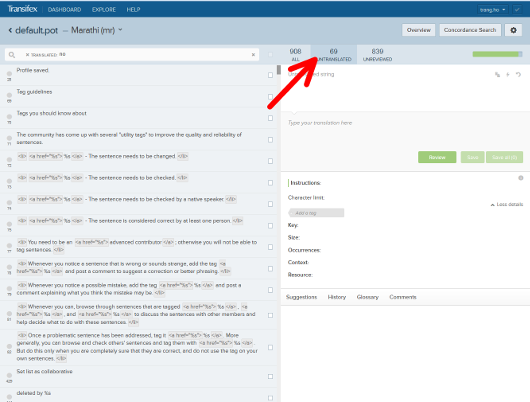Version at: 30/11/2014, 18:37
# Interface Translation
This article explains how you can help us translate the website interface into other languages.
## Accessing the translation platform
We use a platform called **Transifex** to manage the translations of the website. Here's what you have to do in order to join the translators team:
1. Go to this page [https://www.transifex.com/projects/p/tatoeba_website/](https://www.transifex.com/projects/p/tatoeba_website/).
2. If you do not have an account on Transifex: click on "Help translate Tatoeba website" and create your account.
3. If you do have an account: log in, choose the language(s) in which you would like to translate and apply to be a translator.
4. You have to wait for your application to be accepted.
Once you have been accepted as a translator, here's how you can access the list of strings to translate.
1. From your dashboard:

2. Then select the "default.pot" resource:

3. Select "Untranslated" strings:

If you need to learn more about Transifex, you can read their documentation: [http://docs.transifex.com/](http://docs.transifex.com/).
## Translating strings
A "string" is the basic unit of translatable content. It may contain part of a sentence, one sentence, or more sentences.
Some strings include strange words like %s or %1$s. These words acts as placeholders that are replaced by actual words. For instance, in the string "%s's sentences", the **%s** part is replaced by the name of a user, which produces something like "[trang's sentences](http://tatoeba.org/eng/sentences/of_user/trang)". Therefore, when translating such sentences, you need to keep the %s part inside your translation.
Other placeholders include: **%d** (replaces a number), **%1$s**, **%2$s**, **%3$s** and so on, **:count:** (replaces the number of results in a results page).
version at: 30/11/2014, 18:39
# Interface Translation
This article explains how you can help us translate the website interface into other languages.
## Accessing the translation platform
We use a platform called **Transifex** to manage the translations of the website. Here's what you have to do in order to join the translators team:
1. Go to this page [https://www.transifex.com/projects/p/tatoeba_website/](https://www.transifex.com/projects/p/tatoeba_website/).
2. If you do not have an account on Transifex: click on "Help translate Tatoeba website" and create your account.
3. If you do have an account: log in, choose the language(s) in which you would like to translate and apply to be a translator.
4. You have to wait for your application to be accepted.
Once you have been accepted as a translator, here's how you can access the list of strings to translate.
1. From your dashboard:

2. Then select the "default.pot" resource:

3. Select "Untranslated" strings:

If you need to learn more about Transifex, you can read their documentation: [http://docs.transifex.com/](http://docs.transifex.com/).
## Translating strings
A "string" is the basic unit of translatable content. It may contain part of a sentence, one sentence, or more sentences.
Some strings include strange words like %s or %1$s. These words act as placeholders and are replaced by actual words when displayed on the website. For instance, in the string "%s's sentences", the **%s** part is replaced by the name of a user, which produces something like "[trang's sentences](http://tatoeba.org/eng/sentences/of_user/trang)". Therefore, when translating such sentences, you must keep the %s part inside your translation.
Other placeholders include: **%d** (replaces a number), **%1$s**, **%2$s**, **%3$s** and so on, **:count:** (replaces the number of results in a results page).
Note
The lines in green are the lines that have been added in the new version.
The lines in red are those that have been removed.
Actions